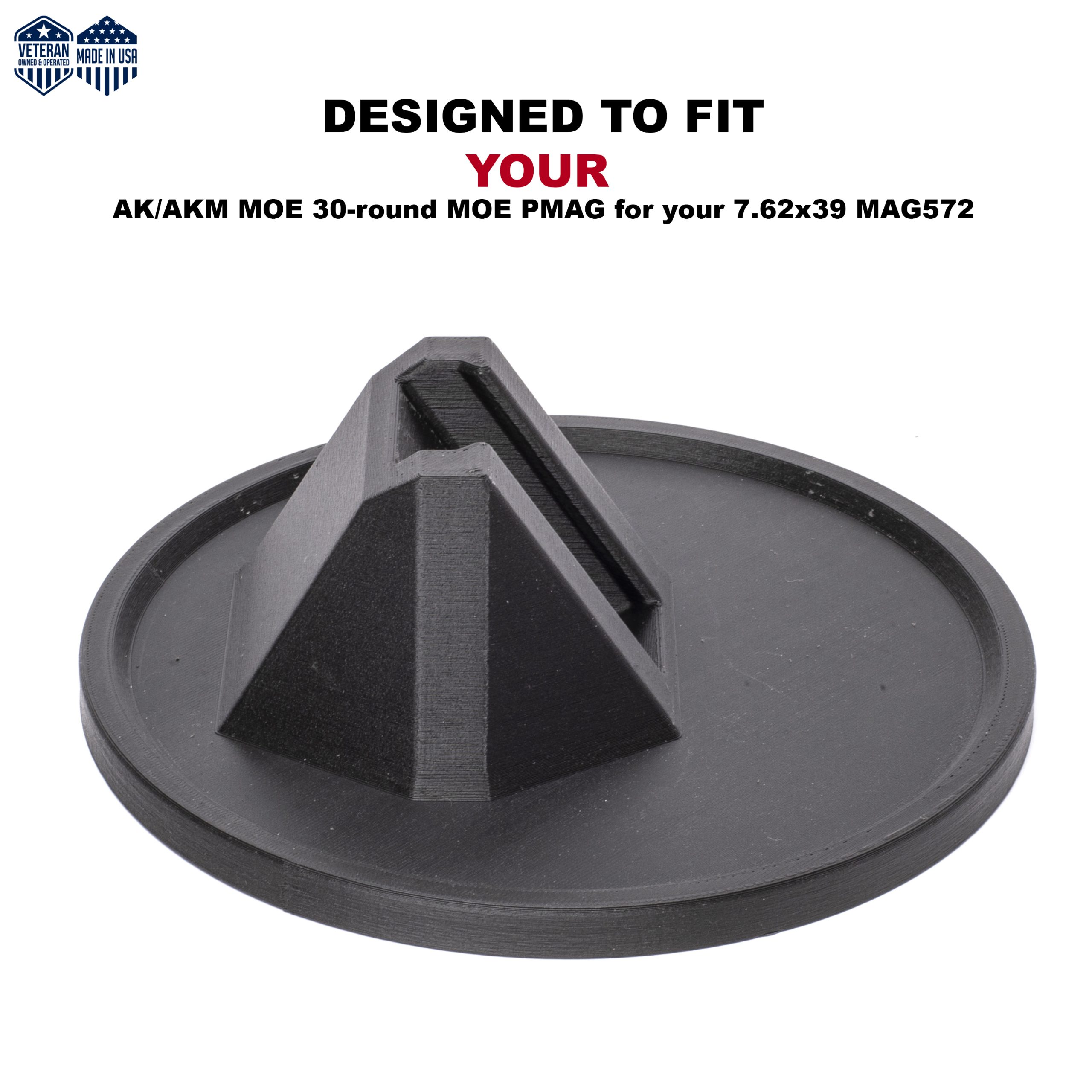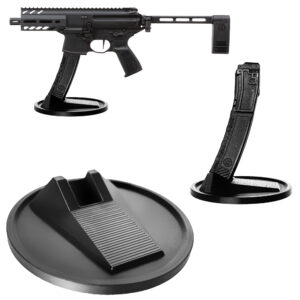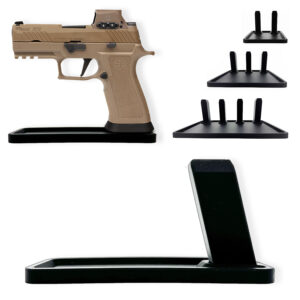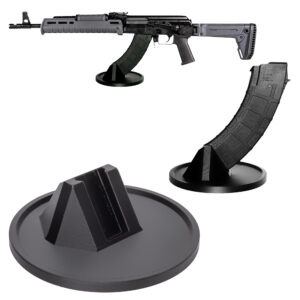
Categories:
The AK-47, a gun renowned for its reliability and widespread use, is not just a marvel of engineering but also an intriguing study in the significance of finishes. The finish of an AK-47 plays a crucial role in its overall durability, affecting both its performance and longevity. While the mechanical design of the rifle ensures that it can function under extreme conditions, the choice of finish can influence how well it withstands environmental factors such as moisture, dust, and temperature fluctuations.
In essence, the finish serves multiple purposes: it provides protection against corrosion and wear while enhancing aesthetic appeal. Various types of finishes are employed in the production of AK-47s—ranging from bluing and parkerizing to modern coatings like Cerakote or Duracoat. Each method comes with distinct properties that impact not only the weapon’s appearance but also its resistance to scratches, chemical exposure, and rust formation.
Understanding these finishes is vital for both manufacturers and end-users. A high-quality finish can significantly enhance a rifle’s lifespan by reducing maintenance needs and improving reliability in adverse conditions. Conversely, subpar finishes may lead to accelerated wear or even failure in critical situations. This is particularly important given that many AK-47s see service in harsh environments where exposure to elements is inevitable.
Moreover, as the market for guns evolves with technological advancements, so too does the approach to finishes on weapons like the AK-47. Enthusiasts often debate which types of finishes provide optimal durability while allowing for customization options that reflect personal preferences. Therefore, exploring how different finishing techniques affect an AK-47’s durability is essential for anyone seeking to understand this iconic gun’s resilience across various contexts and applications.
The finish of an AK-47 plays a critical role in determining the rifle’s overall durability, performance, and resistance to environmental factors. Various types of finishes have been employed throughout the history of the AK-47, each offering distinct advantages and disadvantages that can influence the gun’s longevity.
One of the most common finishes used on AK-47s is bluing. This process involves applying a chemical treatment to steel surfaces that creates a protective oxide layer. While blued finishes provide some degree of corrosion resistance, they are vulnerable to moisture and require regular maintenance to prevent rusting. Consequently, rifles with blued finishes might not perform as well in harsh conditions without diligent care.
Another popular finish is parkerizing, also known as manganese phosphate coating. This method involves immersing the metal parts in a solution that produces a matte gray or black surface. Parkerizing enhances corrosion resistance significantly compared to bluing and provides excellent wear resistance due to its porous texture, which can hold oil and lubricants effectively. As such, an AK-47 with a parkerized finish is better suited for rugged environments where exposure to moisture and dirt is prevalent.
Modern variations often incorporate polymer coatings or other advanced materials that offer additional protection against scratches and impacts while being lightweight. These synthetic finishes can also enhance camouflage capabilities by reducing glare from sunlight—a crucial factor for military applications.
Lastly, some manufacturers utilize Cerakote or similar ceramic-based coatings that provide exceptional durability and resistance against heat, chemicals, and abrasion. This type of finish can dramatically extend an AK-47’s lifespan while maintaining its functionality under extreme conditions.
In summary, the choice of finish on an AK-47 significantly affects its durability by influencing how well it resists corrosion, wear, and environmental challenges—factors critical for maintaining operational readiness over time. Each finishing method reflects different priorities in terms of protection versus aesthetics or weight considerations.
The finish of an AK-47 plays a pivotal role in its overall durability, significantly influenced by the materials used in both the gun’s construction and its protective coating. The AK-47 is traditionally crafted from stamped steel, which provides a robust foundation for the weapon. However, this bare metal is susceptible to various environmental factors such as moisture, salt, and debris that can lead to corrosion and degradation over time.
This is where the finish becomes essential.
Different finishes are applied to the AK-47 to enhance its resilience against wear and tear. Common finishes include bluing, parkerizing, and modern coatings like Cerakote or Duracoat. Each of these materials has distinct properties that contribute to their effectiveness in protecting the underlying metal. For instance, bluing offers a level of rust resistance but may not be as durable as other finishes when exposed to harsh conditions or heavy usage.
Parkerizing creates a rougher texture that holds oil well, providing superior corrosion resistance while also offering some degree of abrasion resistance.
Modern coatings have revolutionized gun finishes by incorporating advanced polymers that not only protect against corrosion but also resist scratches and impacts more effectively than traditional methods. These materials can form a thicker barrier against environmental damage while maintaining flexibility under stress, thus ensuring longevity even with frequent use.
Moreover, the application process itself can influence durability; finishes that are baked on at high temperatures tend to bond more effectively with the metal surface compared to those applied at lower temperatures or without proper preparation. Therefore, understanding how different materials interact within the finish of an AK-47 is crucial for optimizing its performance and lifespan.
In summary, material selection in both construction and finishing processes significantly impacts an AK-47’s durability. A well-chosen finish not only enhances aesthetic appeal but serves as a critical line of defense against factors that could compromise functionality over time.
The finish of an AK-47 plays a crucial role in determining the rifle’s durability, particularly when it comes to its interaction with various environmental factors. These factors can significantly influence how well the finish holds up against wear and tear, corrosion, and overall longevity.
One of the primary environmental challenges faced by guns is moisture. In humid conditions or environments where rain is frequent, the risk of rust increases dramatically. Many standard finishes applied to AK-47s, such as bluing or parkerizing, offer varying levels of resistance to rust but are not impervious to it. A quality finish can create a barrier that slows down oxidation, but if compromised by scratches or dings—common in rugged use—the underlying metal becomes vulnerable.
This susceptibility highlights the importance of regular maintenance and inspection, particularly after exposure to wet conditions.
Similarly, exposure to extreme temperatures can affect the performance and integrity of a gun’s finish. High heat can cause certain coatings to degrade or become brittle over time, while very low temperatures may lead some materials to contract or crack. For instance, synthetic finishes like Cerakote provide excellent durability across temperature extremes but may require proper application techniques to maintain their effectiveness under stress.
Dust and sand are additional adversaries for gun finishes in arid climates or during military operations. Particulate matter can wear down protective layers over time through abrasion while also infiltrating moving parts if not properly cleaned. This emphasizes the need for appropriate storage solutions and protective measures tailored for specific environments.
Ultimately, understanding how environmental factors impact the longevity of an AK-47’s finish is essential for maintaining its operational reliability and aesthetic appeal. A robust finishing process combined with proactive care can ensure that this iconic rifle remains functional even in challenging conditions.
Maintaining the finish of an AK-47 is crucial for preserving its durability and overall performance. The finish not only serves as a protective layer against corrosion and wear but also impacts the weapon’s aesthetic appeal. To ensure that the finish remains intact, a combination of regular cleaning, proper storage, and careful handling practices is essential.
First and foremost, regular cleaning is vital. After each use, it’s important to disassemble the rifle and clean all components thoroughly. This includes removing any dirt, grime, or residue that may have accumulated during firing. A soft cloth should be used to wipe down metal surfaces gently, taking care not to scratch or damage the finish. For deeper cleaning, non-abrasive solvents can be employed to help remove stubborn residues without harming the protective coating.
Proper storage also plays a significant role in preserving the AK-47’s finish. When not in use, it should be stored in a cool, dry environment to prevent moisture accumulation that could lead to rusting or corrosion. A gun safe with humidity control features can offer optimal protection. Additionally, using a breathable gun sock can further shield the rifle from dust and environmental factors while allowing any trapped moisture to escape.
Handling practices are equally important; users should always handle their AK-47 with care to minimize wear on the finish. Using gloves when handling the gun can prevent oils from skin contact that might degrade certain finishes over time. Moreover, avoiding contact with harsh chemicals or abrasive materials during maintenance will help maintain its integrity.
In summary, maintaining an AK-47’s finish involves diligent cleaning routines post-use, appropriate storage conditions to deter moisture exposure, and careful handling techniques that protect against wear. By adopting these practices consistently, owners can significantly extend both the life of their gun’s finish and its overall durability in various conditions.
When considering the durability of an AK-47, the finish applied to the gun plays a crucial role. Factory finishes typically utilize methods such as bluing or parkerizing, which are designed for mass production and provide a decent level of corrosion resistance while maintaining a balance between aesthetics and functionality. Bluing, for example, adds a layer of protection against rust but can wear off over time with heavy use.
Parkerizing, on the other hand, offers superior durability due to its ability to absorb oil and resist abrasion, making it a popular choice for military applications.
In contrast, aftermarket finishing options have gained popularity among enthusiasts looking to enhance both the appearance and longevity of their AK-47s. These finishes can include Cerakote and various types of polymer coatings. Cerakote is particularly renowned for its resilience; it can withstand extreme temperatures and impacts while providing excellent corrosion resistance. This makes it an ideal choice for users who require their guns to perform in harsh environments.
However, aftermarket finishes often come with trade-offs. While they may significantly improve durability and customization options—allowing users to select colors or patterns that reflect personal style—they can sometimes alter the original specifications of the gun. Improper application could lead to issues such as peeling or chipping if not done by skilled professionals.
Ultimately, whether one opts for factory or aftermarket finishes depends on individual preferences regarding aesthetics versus functionality. Factory finishes offer reliability rooted in tradition but may lack modern advancements in protective technology found in some aftermarket solutions. Therefore, understanding these differences is crucial when assessing how finish impacts an AK-47’s overall durability and longevity in varied conditions of use.
In conclusion, selecting the appropriate finish for an AK-47 is crucial for ensuring its longevity and performance in various conditions. The finish not only influences the rifle’s aesthetic appeal but also plays a significant role in protecting it from environmental factors such as moisture, corrosion, and physical wear. Each type of finish offers distinct advantages and limitations that can impact the gun’s overall durability.
For instance, blued finishes are traditional and provide a certain level of protection against rust. However, they may require more maintenance to prevent corrosion compared to modern coatings. Conversely, polymer or synthetic finishes are highly resistant to scratches and chemicals while providing excellent corrosion resistance. These contemporary options have gained popularity due to their lightweight nature and ability to withstand harsh conditions without degrading.
Additionally, understanding the intended use of the AK-47 is essential when choosing a finish. For military or tactical applications where exposure to elements is frequent, a durable coating like Cerakote or other advanced finishes can significantly enhance resilience against wear and tear while minimizing maintenance requirements. On the other hand, collectors may prioritize traditional finishes that reflect historical accuracy over ruggedness.
Ultimately, the decision on which finish to apply should be based on a comprehensive assessment of personal preferences, anticipated usage scenarios, and environmental considerations. By carefully evaluating these factors, gun owners can select a finish that not only complements their style but also maximizes durability—ensuring that their AK-47 remains functional and visually appealing over time. Investing in the right finish ultimately safeguards this iconic gun against deterioration while enhancing its performance capabilities in diverse settings.








Colt
Colt M4 Carbine
Colt LE6920
Colt AR-15 A4
Daniel Defense
DDM4 V7
DDM4 V9
DDM4 V11
DDM4 ISR (Integrally Suppressed Rifle)
Smith & Wesson (S&W)
M&P15 Sport II
M&P15 Tactical
M&P15T
Bravo Company Manufacturing (BCM)
BCM Recce-16
BCM Recce-14
BCM MCMR Series
Aero Precision
M4E1 Series
AC-15
AR15 Pistol (Various Configurations)
Ruger
Ruger AR-556
Ruger SR-556
Ruger AR-556 MPR (Multi-Purpose Rifle)
Springfield Armory
Saint Victor
Saint Edge
Saint AR-15
PSA (Palmetto State Armory)
PSA PA-15
PSA AR-V
PSA Jakl (AR Pistol)
FN America
FN 15 Tactical Carbine
FN 15 Patrol
FN 15 DMR
Wilson Combat
Recon Tactical
Super Sniper
Protector Carbine
SIG Sauer
SIG M400 Tread
SIG M400 Elite
SIG M400 SDI
LWRC International
IC DI (Direct Impingement)
IC SPR
IC A5
Bushmaster Guns
XM-15 QRC
Bushmaster MOE
XM-15 Patrolman
Rock River Arms
LAR-15 Entry Tactical
LAR-15 Predator
LAR-15 Elite Comp
Stag Arms
Stag 15 Tactical
Stag 15L (Left-Handed Models)
Stag 15 Valkyrie
Noveske Rifleworks
Noveske Gen 4 N4
Noveske Space Invader (AR Pistol)
Noveske Recon
Anderson Manufacturing
AM-15 Optic Ready
AM-15 M4 Carbine
AM-15 Precision Rifle
Adams Arms
AA-15 Piston Rifle
P2 AARS (Adams Arms Rifle Series)
Black Rain Ordnance
SPEC15 Series
BRO Predator
Fallout 15
Diamondback Guns
DB15 Series
DB15CCMLB
DB15EB
Del-Ton Inc.
DTI-15
Del-Ton Echo 316H
Sierra 316M
Windham Weaponry
Windham SRC
Windham VEX-SS
Windham RMCS-4 (Caliber Conversion System)
Christensen Arms
CA-15 G2
CA-15 Recon
CA-15 Titanium Edition
Patriot Ordnance Factory (POF-USA)
Renegade Plus
P415 Edge
Revolution DI
LaRue Tactical
PredatAR
OBR (Optimized Battle Rifle)
LaRue Stealth 2.0
Battle Arms Development
Workhorse Patrol Carbine
BAD556-LW (Lightweight)
Authority Elite Rifle
Faxon Guns
Ascent AR-15
FX-19 (AR Pistol)
Streamline Ultralight Series
KE Arms
KE-15 SLT (Super Lightweight Tactical)
KE-15 Scout Carbine
Primary Weapons Systems (PWS)
MK1 MOD 2-M
MK116 PRO
MK107 (Piston AR Pistol)
ZEV Technologies
ZEV Core Elite Rifle
ZEV AR15 Billet Rifles
Franklin Armory
BFSIII AR-C1
Militia Model
F17-L (Chambered in .17 WSM)
Seekins Precision
SP15 DMR
NX15 Skeletonized Rifle
Havak Bravo
Aero Precision (Additional Models)
EPC-9 (Pistol Caliber ARs)
VG6 AR Rifles
Barrett Guns
REC7 DI
REC7 Gen II
CMMG
MK4 RCE
Resolute 300
Banshee (AR Pistol)
DPMS Panther Arms
Panther Oracle
Panther LR-308
H&K (Heckler & Koch)
HK MR556A1
HK416 (Military Variant)
Rock Island Armory (Armscor)
VR-80 Tactical AR (Shotgun AR Platform)
Troy Industries
Troy SPC-A3
Troy PAR (Pump Action AR)
Wilson Tactical
Tactical Recon AR
Protector Series
F1 Guns
FDR-15 Skeletonized Rifle
BDRx-15 Series
Juggernaut Tactical
JT-15
JT-10 Precision Rifle
AeroSurplus
Surplus AR-15 Rifles (Budget Models)
Thunder Tactical
AR-15 Basic Carbine
Tactical Builder Sets
Radical Guns
RF-15
Forged AR-Series
Dark Storm Industries
DS-15 Featureless Rifles
DS-10 Typhoon
DRD Tactical
Paratus
Aptus AR Rifles
Bear Creek Arsenal
BCA-15
AR Complete Upper Builds
Aero Survival Rifles (ASI)
ASR Tactical Series
Tactical Edge
WARFIGHTER Series
AR-15 Lightweight Rifles
Lone Star Armory
TX15 DMR
TX15 Carbine
HERA Arms
HERA H7
HERA AR-15 Lower Builds
IWI (Israeli Weapon Industries)
Zion-15
DRD Tactical
Tactical Modular Rifles
Quick-Takedown Rifles
V Seven Weapons
1776 Rifle
Hyperlite Rifle
Core Rifle Systems
Core15 Tac III
Core15 Patrol Rifle
Armalite (Original AR-15 Creator)
M15 Tactical
M15 A4 Carbine
DEF15 (Defensive Sporting Rifle Series)
PSA (Palmetto State Armory Additional Models)
PSAK-47 Hybrid (AR-AK Style Hybrid)
PSA Dagger (Pistol Caliber Configurations)
Odin Works
OTR-15
Odin Recon Rifle
Maxim Defense
MDX-508 PDX (Compact AR Pistol)
MDX-510 Rifle